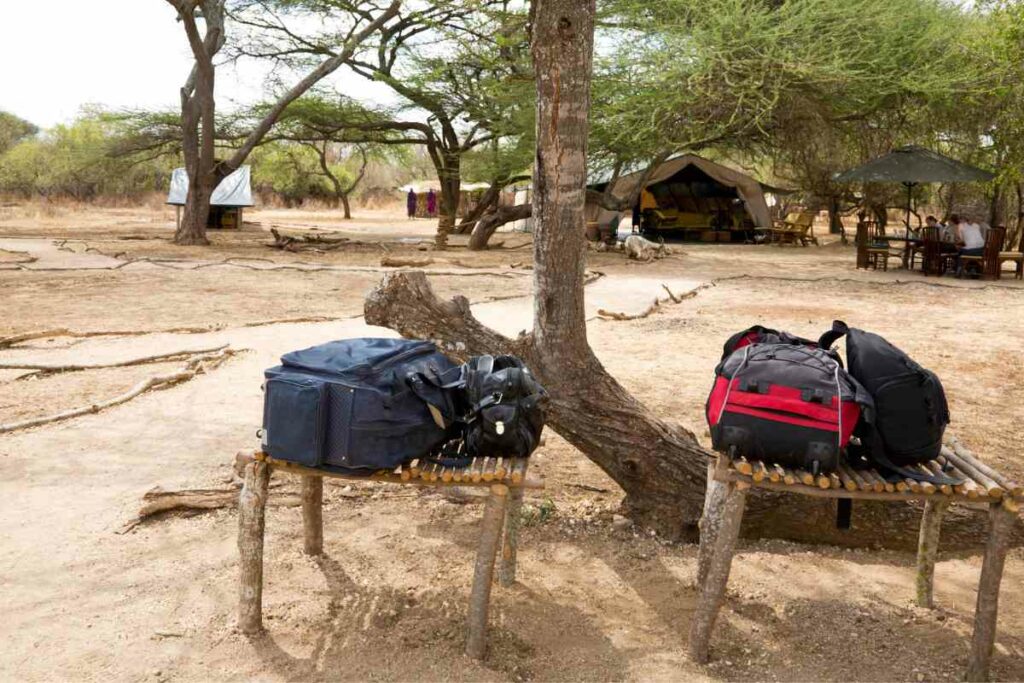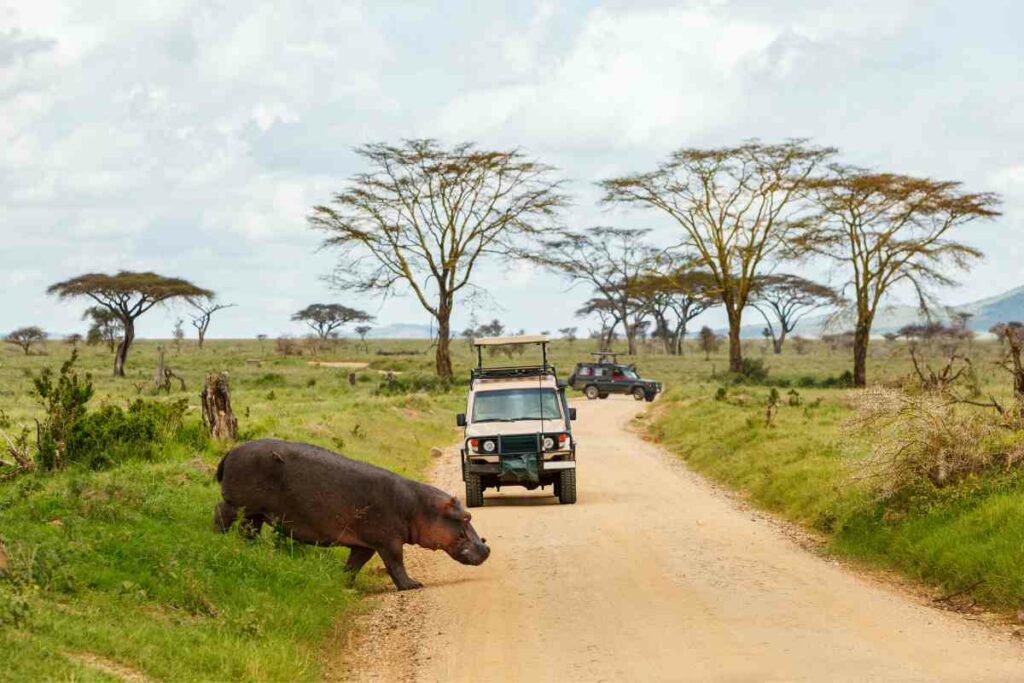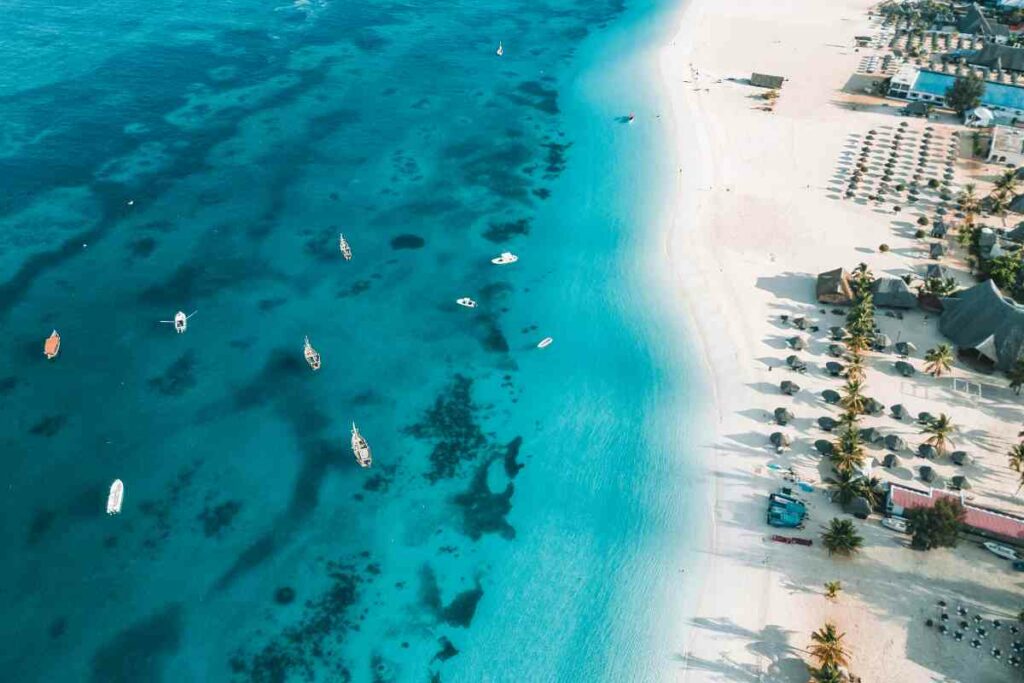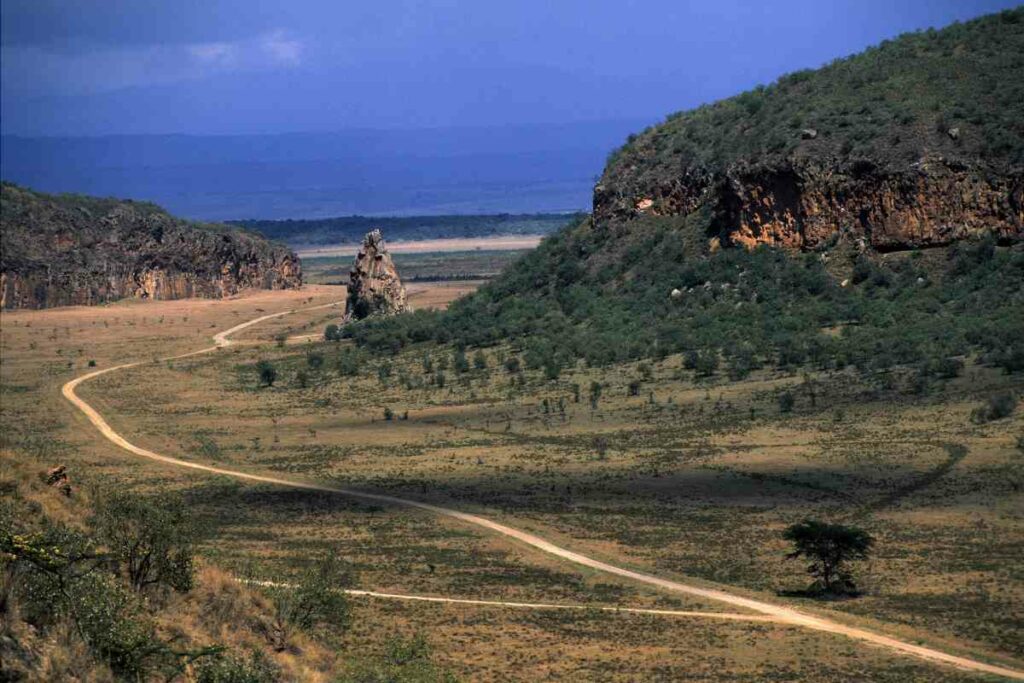You may recognize the Serengeti from the numerous movies and documentaries shot there.
However spectacular, the cameras can only capture a glimpse of what this ecosystem has to offer.
The guide will cover all the crucial aspects of the Serengeti ecosystem so that you can have a successful and memorable safari adventure.
Brief History
Serengeti is a Masai word meaning ‘endless plains.
Despite not being the largest park in Tanzania (3rd), the Serengeti is the most iconic.
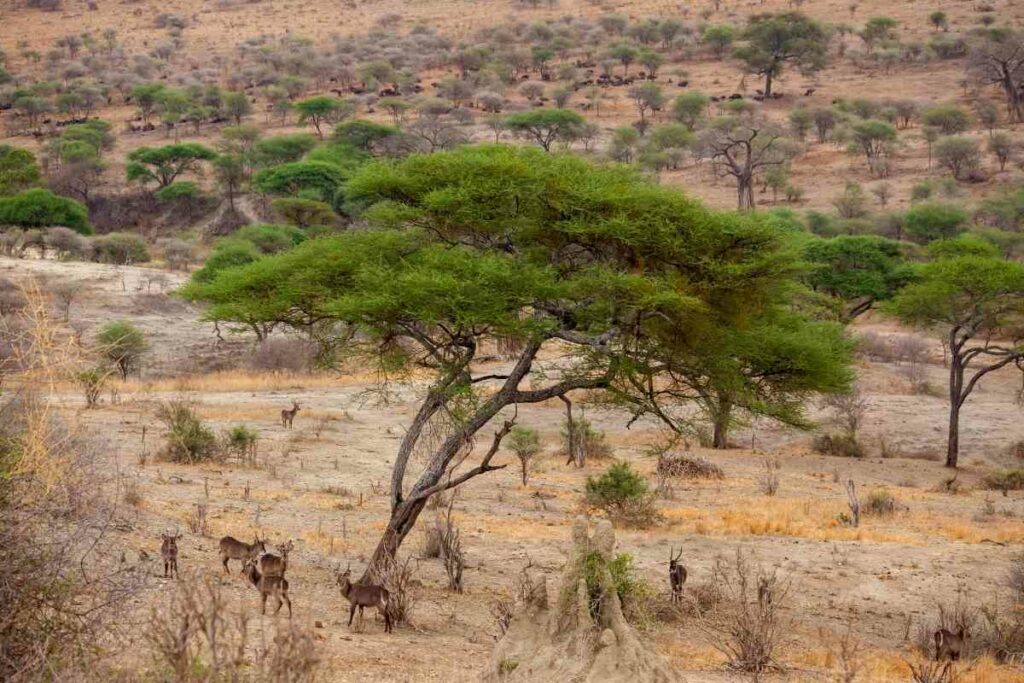
Spanning approximately 5,7000 square miles, the park in Northern Tanzania borders:
- the Maasai Mara to the North
- the Ngorongoro Conservancy to the East
- Lake Victoria to the West
Due to its diverse terrain and vegetation, the park hosts many animals, from the big five, hippos, giraffes, hyenas, antelopes, wildebeests, crocodiles, and insects, to numerous bird species.
While south Serengeti is primarily grasslands, the northern region has plenty of rolling hills and woodlands.
The western part is a savannah with scattered thorn trees and has riverine forests along the Grumeti River.
Top Attractions
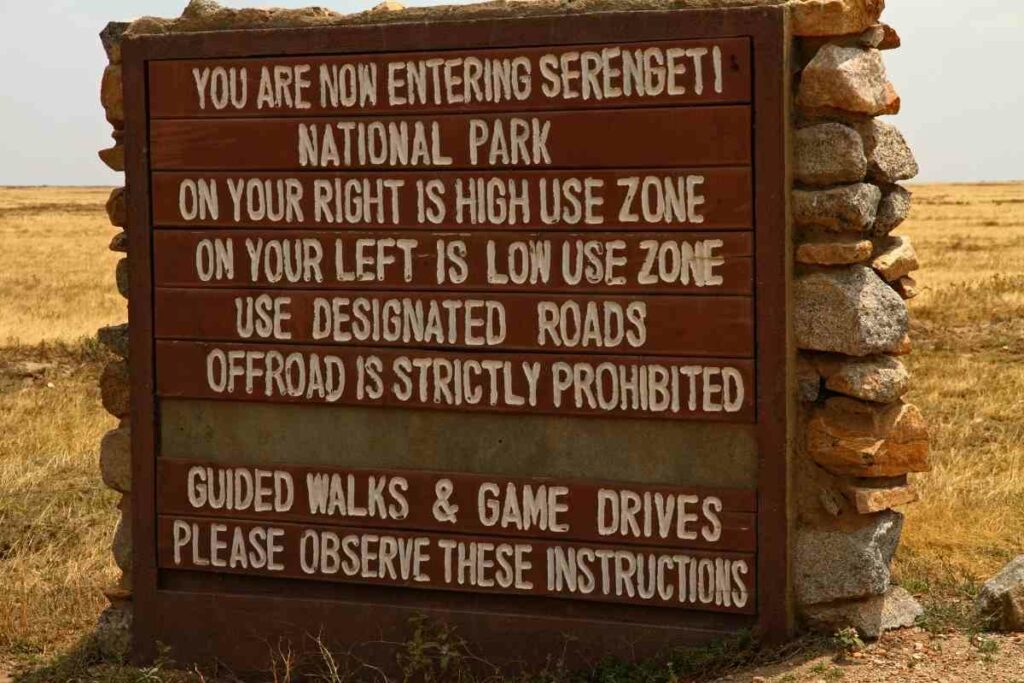
The Wildebeest Migration
The Serengeti is home to the largest concentration of wildebeests in the globe, an estimated 1.5 million wildebeests.
Accompanied by a strong contingent of around 500,000 zebras and Thomson gazelles, the animals make an annual circular migration around the Serengeti-Mara ecosystem in search of greener pastures.
The herd’s path is directed by the wildebeest’s excellent instinct of where it is raining.
You can track the migration all year long across different park sectors.
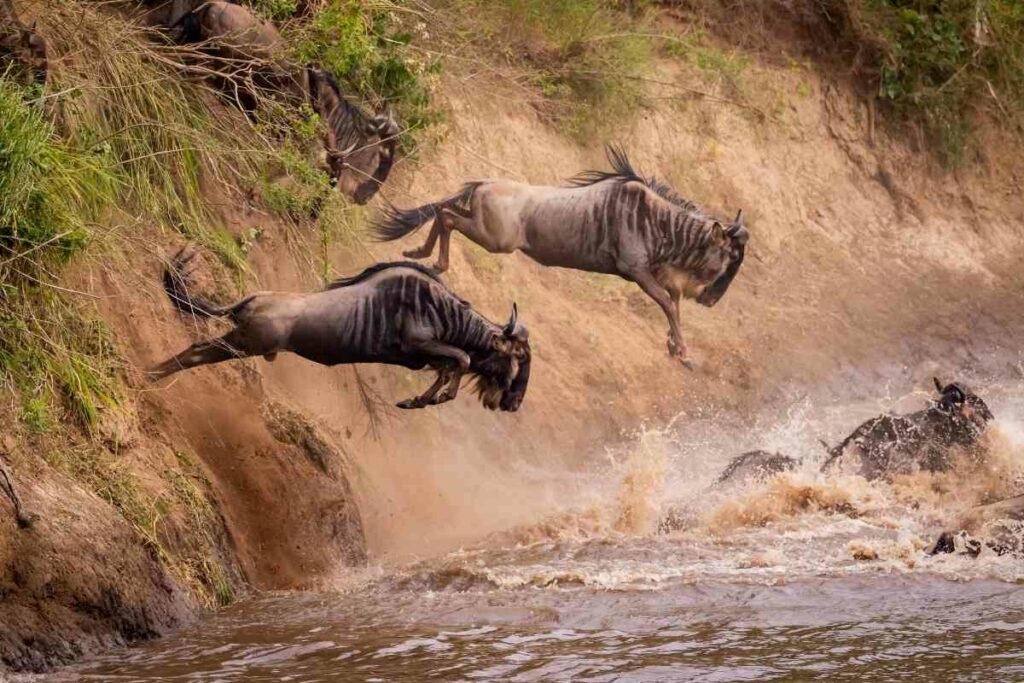
Their migration usually kicks off in the open southern plains after the calving season. All the pregnant cows give birth in broad daylight for 2 to 3 weeks in February.
Up to 500,000 calves are born, translating to over 23,000 daily.
The calves are born ready and start running with the herds within 24 hours of birth.
Predators swiftly move to feast on the newborns, but it’s only a tiny dent in the overall population.
With the grass depleting in the plains, the herd heads west towards the Grumeti region, where the grass is in plenty after the onset of the rainy season in March.
The long rains will last until May bringing back pomp and color into Serengeti’s western corridor.
While it gets a fresh injection of life, the heavy rains disrupt game drives, making animals harder to spot with the dense vegetation.
Besides, the Wildebeest crossing the Grumeti River heading north is not as thrilling as the Mara.
The herds start arriving at the banks of the Mara in late July, but the murky Mara River stands in their way to better grazing fields in the Masai Mara.
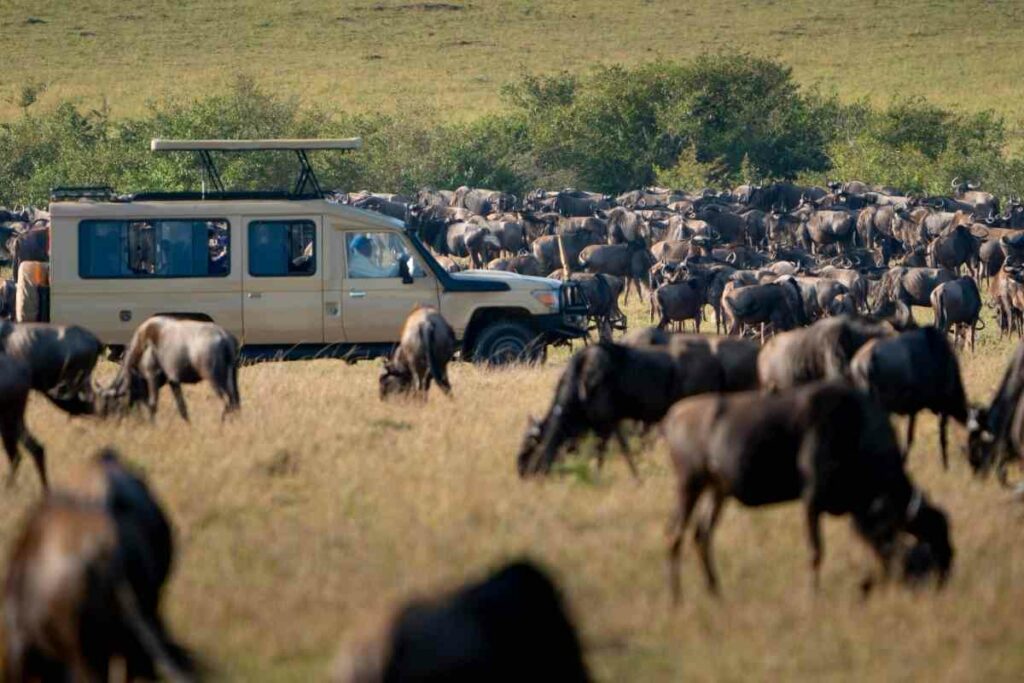
With the dry season in full swing, the animals must brave the fear of drowning and the Nile crocodiles or starve to death.
Starvation kills more wildebeests than all the Serengeti predators combined.
Each day, more and more animals arrive on the shores of the Mara River, decimating any grass that was left.
The animals have no choice but to attempt to cross the river.
The crossing at various points along the river is absolute chaos.
On Land – A stampede ensues as more herds edge closer to the shores while some desperately want to turn back.
The animals try to stay afloat while battling the Mara River’s waves and Nile crocodile onslaught.
During the few days of crossing, up to 50,000 animals will lose their lives around the Mara River.
The herds will stay in the Masai Mara for a few months, typically around late October, before crossing back into the Serengeti.
They will then head south to the plains to calve as the short rains start in November through early January.
Big Five
The ‘Big Five’ name is a pre-colonial term that trophy hunters used to refer to the most challenging animals to capture in the African jungles.
Lions, black rhinos, African bush elephants, leopards, and cape buffalos were revered due to their ferocity when cornered.
Buffaloes
To date, buffaloes are still known to be ill-tempered, and even the brave lions of wary when attacking a calf with the herd nearby.
Trophy hunting took a heavy toll on the population of these animals, especially the black rhino.
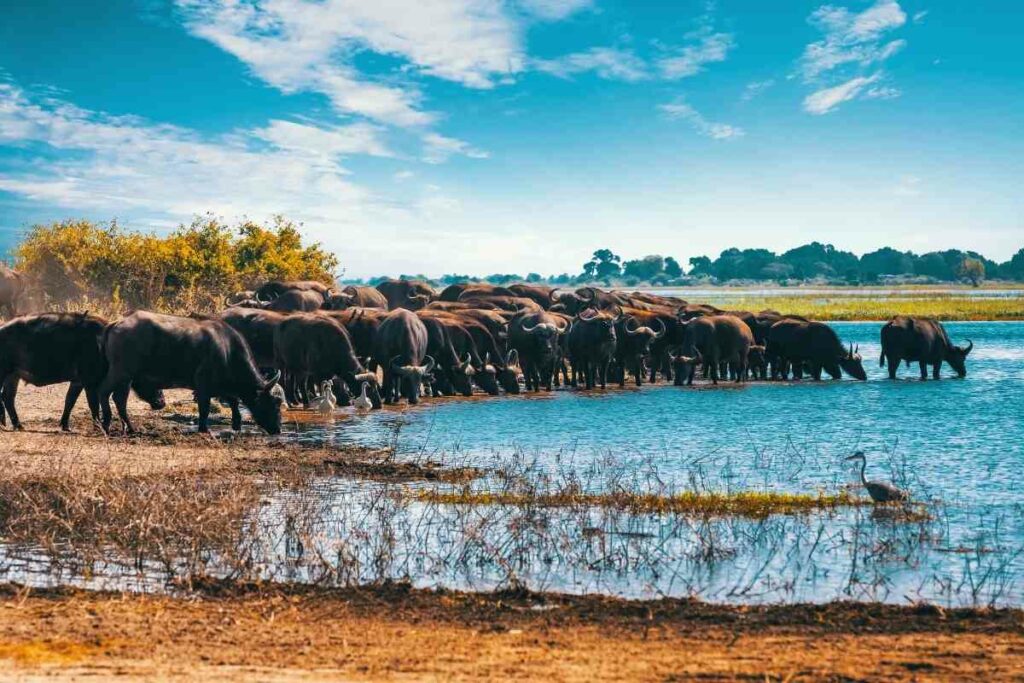
While you can find a few rhinos in their natural habitats across the Serengeti, they are always under the key monitoring of rangers as notorious poaching factions still exist.
Sanctuaries have been established around the Serengeti to care for old and injured rhinos as well as help them procreate.
Lions
You can easily spot lions in the grasslands or the rocky kopjes of the park.
The sociable big cats usually depend on the pride to protect and raise their cubs.
You can also encounter a lion patrolling its territory to wade off any aspiring males in the vicinity.
The older the lion, the darker and bushier the mare.
Leopards
Leopards are also master hunters and thrive in forested areas.
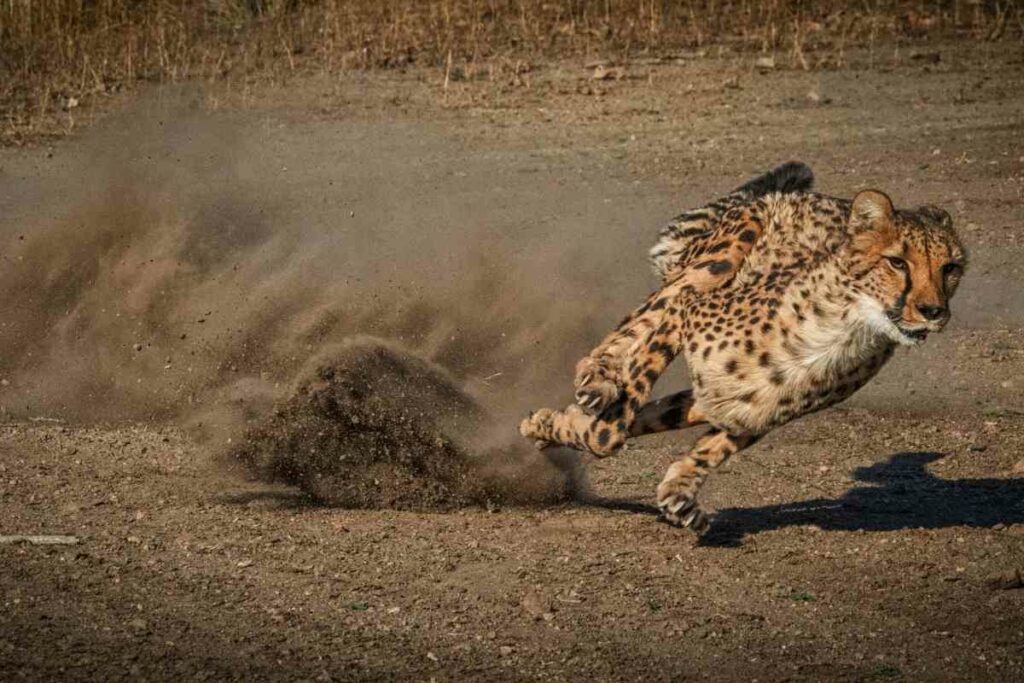
They don’t do much running as the other big cats and depend on their impeccable timing and agility to make a kill.
After having their fill, they usually carry their prey up the trees to avoid marauding hyenas and lions.
Elephants
African bush elephants are inconspicuous due to their size, and sightings are common.
They reside in herds of 3-25 members led by a matriarchal mother. She is usually the oldest and the largest in the pack.
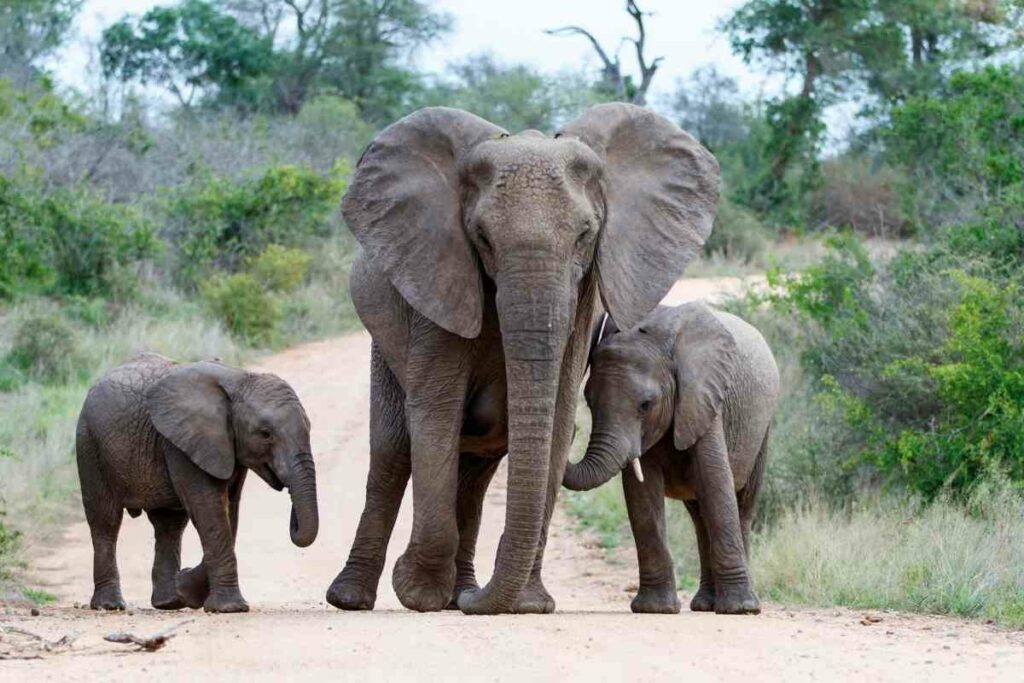
Adult male elephants (bulls) are solitary, moving from one herd to another in search of receptive mating partners.
You can also spot elephants near shallow water points during hot days, spraying their skins with water to cool off.
Predators
Naturally, the huge herbivore herds in the Serengeti attract a corresponding host of predators to maintain an ecological balance.
The most common predators in the park include:
- lions
- leopards
- cheetahs
- spotted hyenas
- and golden-backed jackals
If you are lucky, you can also see serval cats, mongooses, and African wild dogs.
Lions are the apex predators and are efficient as solo or pride hunters. Hyenas have the strongest bite among the predators (800 pounds per inch) but prefer stealing food from the big cats.
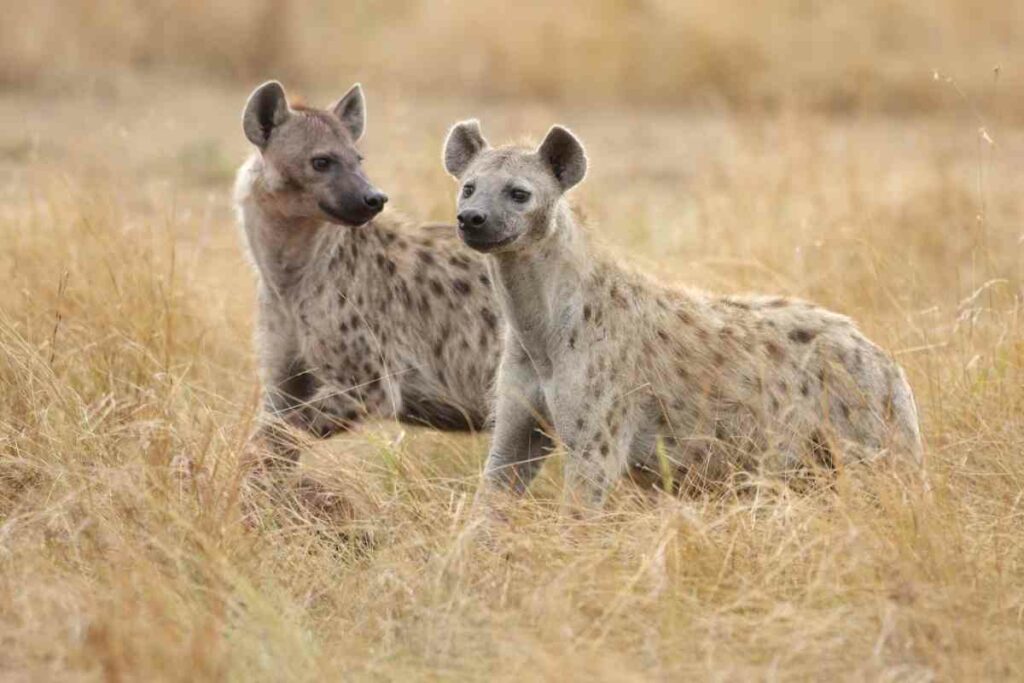
They also prey on young lion cubs and are very dangerous in packs; they can easily overpower and kill a lion.
The Seronera region is in the wild west of Serengeti and has the highest concentration of predators.
While lion hunts are the most common, cheetahs offer the most electrifying experience.
The fastest land animal (0-60 miles in 3 seconds) has a very low endurance and can’t sustain the high-speed dash for more than 30 seconds.
As a Result – Their hunts end up pretty fast, but the adrenaline of witnessing one is unmatched.
The best places to view the action during the dry seasons are close to water points.
Chasing prey across the open savannah is draining, and the predators set ambushes as the animals come down to have a drink.
The brawl that ensues during a chase attracts even more predators who will set their sights on animals separated from their herds.
Bird Watching
The Serengeti should definitely be on your bucket list if you are an avid bird enthusiast.
The park has recorded over 540 species of endemic and migratory birds.
Some bird species you can only find in Serengeti include
- The rufous-tailed weaver,
- The red-throated tit
- The grey-throated spurfowl
- The schalow’s turaco
- The grey-crest helmet shrike.
For the best bird-watching experience in the Serengeti, pack your binoculars and join the evening nature walks around the Ngorongoro crater.
More trees mean more insects and, consequently, more birds.
From the giant secretary bird to the tiny sunbird, the area is awash with the most beautiful birds on the planet.
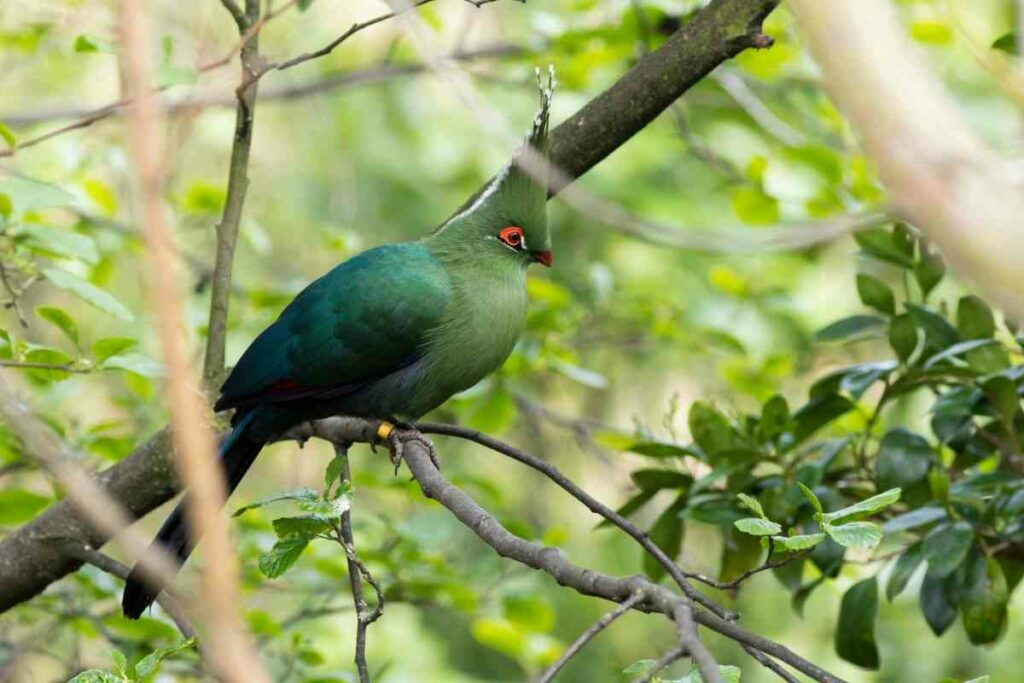
Black eagles abound around the Lobo cliffs, while the African fish eagle domiciles around Lake Victoria and the Grumeti River.
Countless species of vultures circle the Serengeti skies for leftovers.
A high presence of these birds in an area indicates a predator, most often lions nearby.
This information is helpful for safari guides and other scavengers like the dotted hyenas.
Best Time To Visit The Serengeti
The Serengeti ecosystem is always buzzing with wildlife action, no matter the time of the year.
However, June to October is the best time to visit the Serengeti.
Up in the North, it’s time for the iconic annual Great Wildebeest Migration.
The dry season thins out the vegetation making the wildlife move closer to permanent rivers and watering holes.
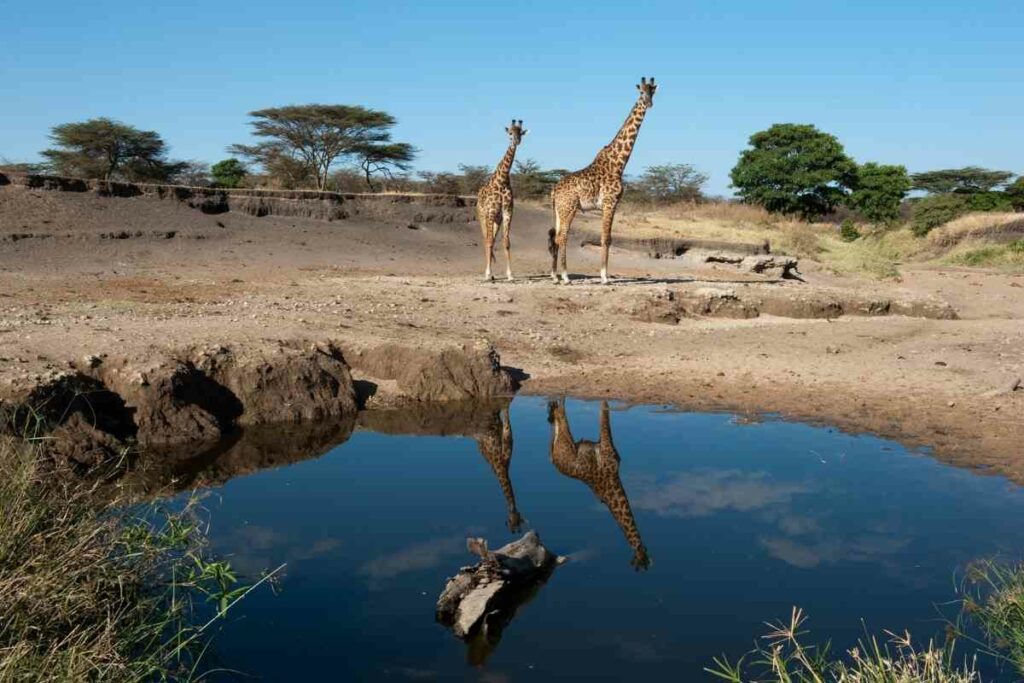
Circling the popular water points, you can see up to 100,000 animals daily.
The bare land and short grasses also allow you to see the big cats in action or stalking prey.
The weather is also pleasurable this time of the year.
Bright, sunny skies with an average daily temperature of 25 degrees Celsius are ideal conditions for a safari adventure.
Remember to apply some sunscreen, carry a hat, and have sunglasses.
It can get pretty hot during the day, and occasional winds can send clouds of dust your way.
November to March is ideal if you don’t mind the mild, wet season.
It is the wildebeest’s calving season in Seronera, and there is plenty of predator action.
Swarms of migratory birds return to the Serengeti.
Starlings and dunlins usually put on mesmerizing acrobatic flight patterns as they glide across the now lush green landscape.
How To Get To Serengeti National Park
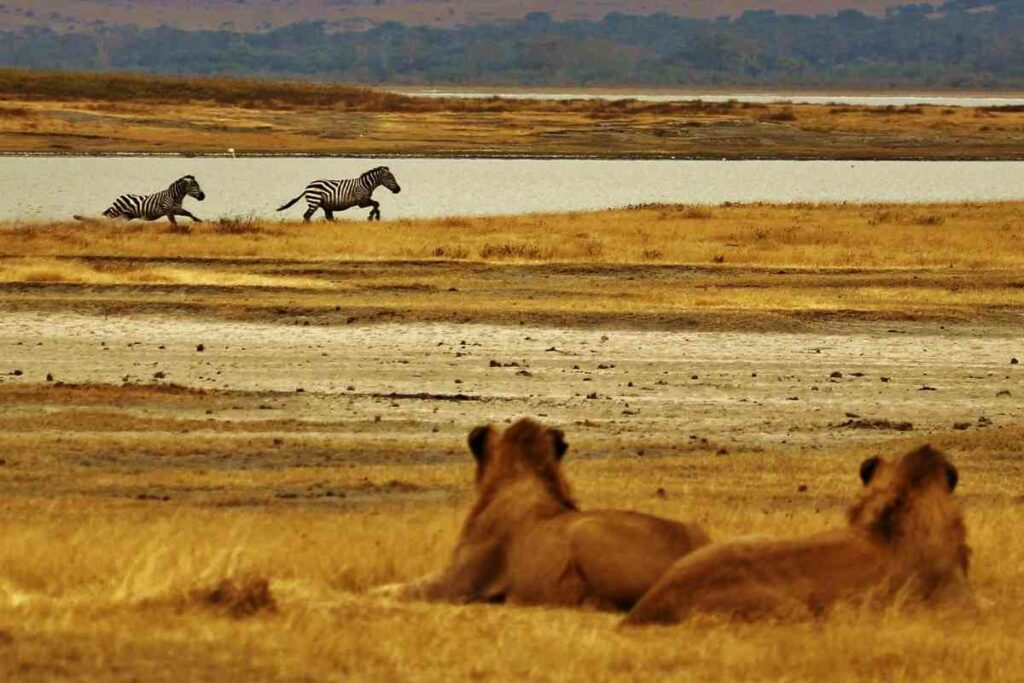
The Serengeti covers a large geographical area, and you can access it by air or road from different parts of the country.
Air
Flying to Serengeti is the most convenient way to get to the park.
The Arusha Airport is closest to the air facility and offers daily flights into the airstrips strewn across the park.
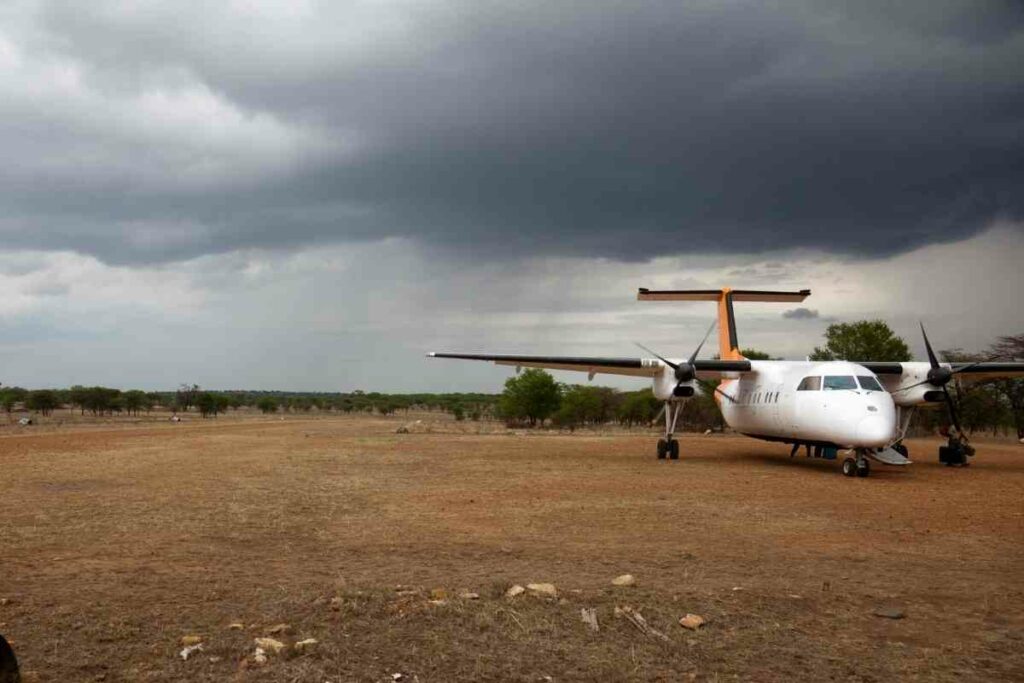
Air tickets usually range from $300-$600 depending on the location of the adjacent airstrip and the airline company.
During the peak seasons, ticket prices will soar, and the number of daily flights into the park will increase.
The main airstrips in the Serengeti are:
- Seronera airstrip – Seronera Town, Central Serengeti
- Kusini airstrip – Kusini Kopjes, Southern Serengeti
- Lobo airstrip – Lobo Area, North East Serengeti
- Fort Ikoma airstrip – Ikoma, North West Serengeti
- Kogatende airstrip – Banks of the Mara River, North Serengeti
- Kirawira B airstrip – Western Serengeti
- Ndutu Airstrip – South East Serengeti
You can also fly in from the Kilimanjaro International Airport, Julius Nyerere International Airport in Dar es Salaam or the Jomo Kenyatta International Airport in Nairobi.
However, you will have to juggle between flight and road transfers.
Road
The Serengeti is 208 miles away from Arusha, the closest major town.
It is a long, 8-hour drive occasioned by several stopovers.
The perks of traveling by road are you will have a sneak peek of the Ngorongoro Crater and Mount Meru along the way.
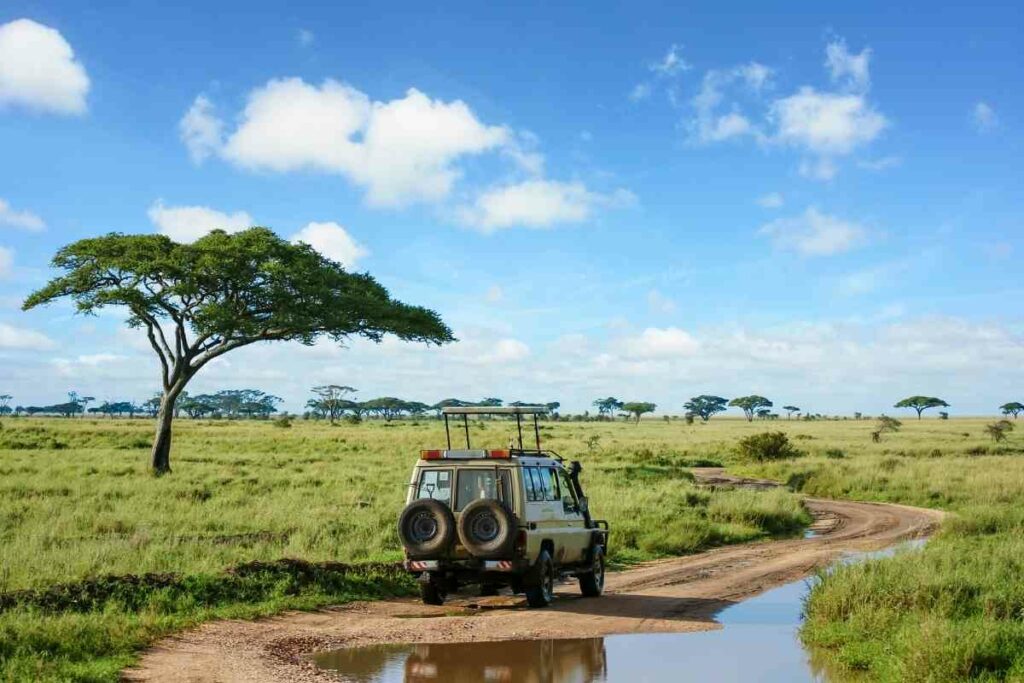
Opt for drive-in safari services, which usually do pickups directly from the airport.
Besides being cheaper and more convenient than self-drive rentals, they know the terrain better and often have some refreshments on board.
You can access the park through its various gates.
They are:
- Naabi Hill Gate – It is Serengeti’s main entrance. Located in Eastern Serengeti, it is busy all year long, having the best lodges and campsites. Other amenities near the gate include two fuelling stations, a tourist information center, shops, and the Serenora Airstrip. You can also use the entrance to access Lake Ndutu, Lake Ngorono, Oogol Kopjes, and the archaeological Olduvai Gorge Museum.
- Klein’s Gate – Serves the North Eastern part of the Serengeti. It is 1km away from the Kogatende airstrip and 7km from the Lobo airstrip. The gate offers easy access to the Loliondo Game Controlled Area, Lobo Kopjes, Bologonja Springs, and the Laremangi salt licks.
- Ndabaka Gate – Serves the Western corridor of the Serengeti. A one-and-a-half drive from Mwanza Town, you can use this get to explore the Grumeti Reserve, Lake Victoria basin, and the Balili View Point. The Kirawira B airstrip is 2km away from the gate.
- Fort Ikoma Gate – The gate is in the North Western Part of the Serengeti. It is 9 kilometers from the historical Fort Ikoma site and a few kilometers from Nyabogati and Retima hippo pools. It is also used for transfers from the Fort Ikoma Airstrip, a kilometer away.
- Bologonja Gate – It is more of a security checkpoint along the Serengeti and Maasai Mara border. A nearby ranger’s post keeps track of the wildlife movement and deters poachers from crossing over to the Kenyan side. The gate is rarely used due to its remote position, and tourists cannot cross the international border without proper permits.
All the gates open from 0600 to 1800 hours but only Naabi Hill Gate accepts entries after 1600 hours.
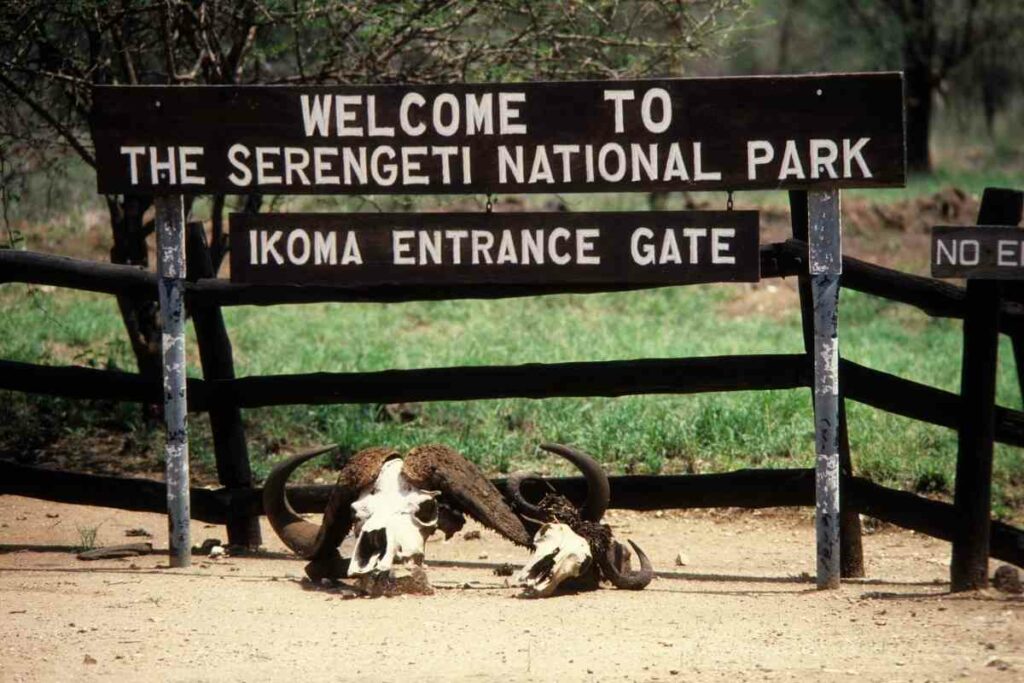
If using the other gates, ensure you have checked in by the stipulated time to avoid inconveniences.
Serengeti National Park Gate Charges
The entry fees for foreigners are slightly marked up.
Adults pay $60, and children aged 5-16 pay $30.
The park waivers the costs for children below five years.
The gates do not accept cash payments, so you better carry your MasterCard or Visa debit card.
Camping fees vary with the seasons:
- Adults can pay from $30 during the off-peak season to $60 in the peak months.
- For children (5-15 years), the fees range from $10 to $15.
If you are coming for filming purposes, you will pay $300 per day, including entrance, camping, and filming costs.
Other charges may include $20 guide/ranger fees which are necessary if it’s your first time in the Serengeti.
Final Word
Termed the best African Safari destination by numerous accredited institutions, the Serengeti should be one of the names on your bucket list.
Now that you know what to look forward to in the Serengeti start planning your next vacation.
We can boldly say it will be worth your while and most likely exceed your expectations.



